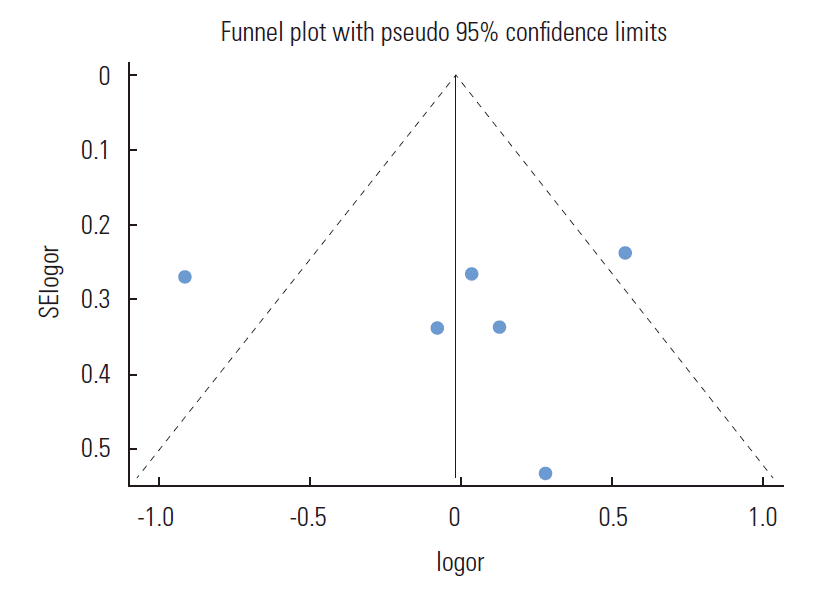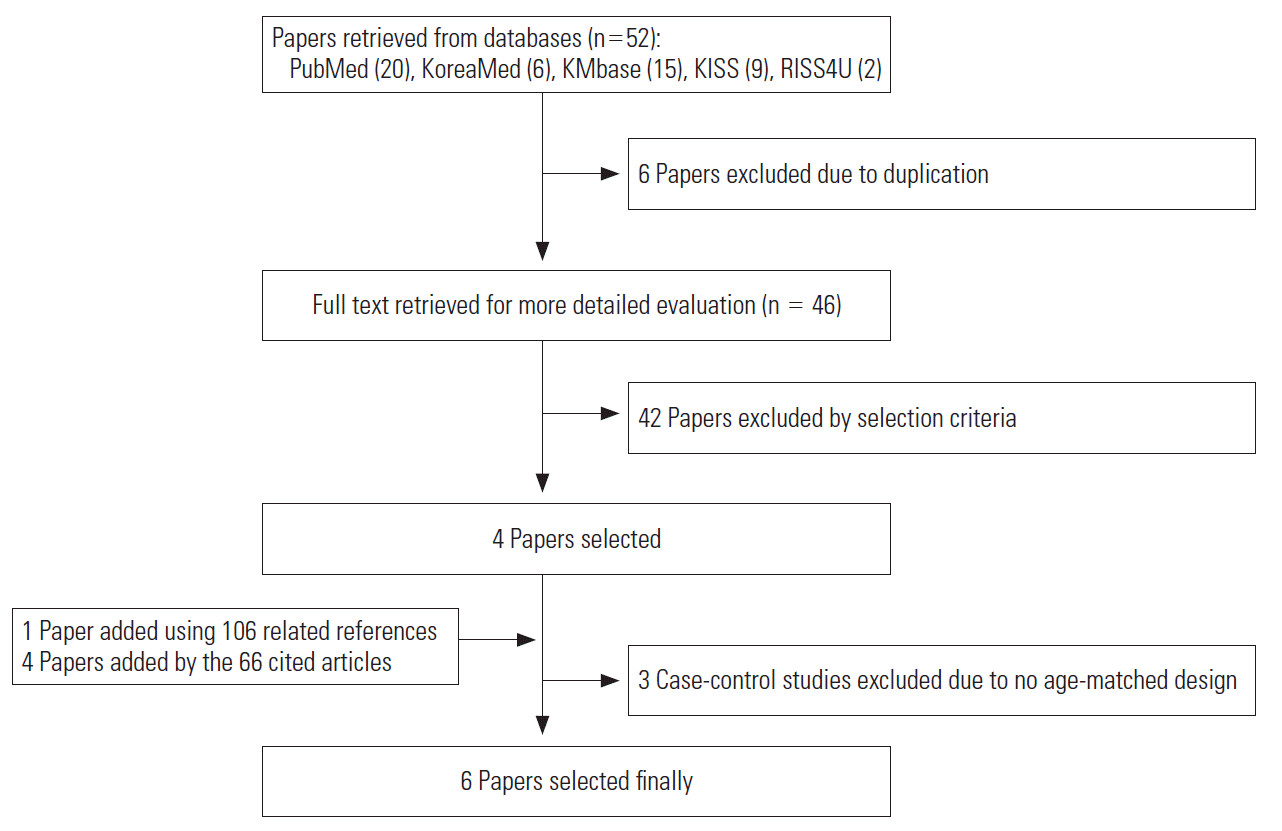Hormone Replacement Therapy and Risk of Breast Cancer in Korean Women: A Quantitative Systematic Review
Article information
Abstract
Objectives:
The epidemiological characteristics of breast cancer incidence by age group in Korean women are unique. This systematic review aimed to investigate the association between hormone replacement therapy (HRT) and breast cancer risk in Korean women.
Methods:
We searched electronic databases such as KoreaMed, KMbase, KISS, and RISS4U as well as PubMed for publications on Korean breast cancer patients. We also conducted manual searching based on references and citations in potential papers. All of the analytically epidemiologic studies that obtained individual data on HRT exposure and breast cancer occurrence in Korean women were selected. We restricted the inclusion of case-control studies to those that included age-matched controls. Estimates of summary odds ratio (SOR) with 95% confidence intervals (CIs) were calculated using random effect models.
Results:
One cohort and five case-control studies were finally selected. Based on the heterogeneity that existed among the six studies (I-squared=70.2%), a random effect model was applied. The summary effect size of HRT history from the six articles indicated no statistical significance in breast cancer risk (SOR, 0.983; 95% CI, 0.620 to 1.556).
Conclusions:
These facts support no significant effect of HRT history in the risk of breast cancer in Korean women. It is necessary to conduct a pooled analysis.
INTRODUCTION
Hormone replacement therapy (HRT) improves quality of life in menopausal women by alleviating symptoms related to menopause and slowing the progression of osteoporosis [1-3]. In spite of these benefits, the greatest reason that menopausal women show a negative attitude towards HRT is because of worries about breast cancer [3,4].
The publication of results in 2002 from the large-scale randomized clinical trial by the Women’s Health Initiative (WHI) proved a great turning point in the debate about the occurrence of breast cancer resulting from HRT in post-menopausal women [5-7]. There was a considerable shift in concepts before and after 2002, and the concept that deserves the most attention is that the administration of estrogen alone does not increase the incidence of breast cancer [7,8]. However, there have been worries that estrogen does not help prevent cardiovascular diseases and that it increases breast cancer [2], and so HRT prescriptions have rapidly decreased since the publication of the WHI study [1,9].
Meanwhile, the incidence of breast cancer displays different patterns according to ethnicity [10]. In the US, where breast cancer shows the highest incidence among cancers in women, Asian Americans show a relatively lower incidence and higher survival rate [11,12]. Furthermore, the incidence trends even show different patterns for different Asian countries [13,14]. In particular, in terms of incidence curves by age group in nine Asian countries, Korea shows a unique trend of decreasing incidence beyond the age of 50 years old [4,10,13,15-17].
Hence, considering the breast cancer incidence characteristics of Korean women, in whom incidence actually decreases with age beyond 50 years old with peri-menopause, one might suspect that the risk of breast cancer from HRT is lower than that of other countries, in which incidence increases with age [2]. Therefore, the aim of our study was to assess the risk of breast cancer due to HRT in Korean women. To this end, we performed a systematic review of analytical epidemiology studies related to breast cancer in Korean women.
METHODS
Search and Selection
The selection criteria for studies were as follows: (1) analytical epidemiology studies on breast cancer in Korean post-menopausal women; (2) individuals providing data about their status of HRT medication; (3) case-control studies needed to include an age-matched control group.
On the basis that these were studies investigating breast cancer in Korean women, and the hypothesis that the hormone formulation would be for oral administration, we used the following search term formula: {(Korean) AND (breast) AND (cancer OR neoplasms) AND [(hormone replacement therapy) OR (oral contraceptives)]}. Taking into account publications in not only overseas journals, but also domestic journals, we applied our search formula to five information portals: PubMed (http://www.ncbi.nlm.nih.gov/pubmed), KoreaMed (http://www.koreamed.org/SearchBasic.php), KMbase (http://kmbase.medric.or.kr/Default.htm), KISS (http://kiss.kstudy.com/), and RISS4U (http://www.riss.kr/index.do). We performed manual searching of the reference literature of papers obtained from our search, and we used a snowballing search for papers that cited papers that met our search criteria [18-21].
Statistical Analysis
From the final selection of papers, we calculated relative risk (RR) or odds ratio (OR), as well as 95% confidence intervals (CIs), based on the frequency distribution of status of HRT medication and breast cancer occurrence. We calculated the standard error of log relative risk by applying the equation [ln (OR_upper) – ln (OR_lower)]/3.92, using the upper 95% CI (OR_upper) and the lower 95% CI (OR_lower) [22].
We tested heterogeneity using I-square values (%) [23], and according to the result, we performed meta-analysis to obtain the effect size (ES) and its 95% CI using a random effect model. In order to evaluate the effect of small-scale studies, we performed Egger’s test for small-study effects, and in order to test for publishing errors, we confirmed symmetry of the funnel plot. The statistical significance level was defined as 5%, and we used the Stata/SE version 14 (StataCorp., College Station, TX, USA) to perform the meta-analysis and to draw the two plots.
RESULTS
The Selected Articles
When we applied our search function to the five information portals, we produced a list of 20, 6, 15, 9, and 2 articles respectively, constituting a total of 52 (Figure 1). Excluding six duplicate articles, we reviewed the content of the remaining total of 46 articles, and found a total of 4 that fitted our search criteria [24-27]. Among the papers cited in these 46 articles, we also identified an additional 106 papers about Korean women, and after reviewing the contents of these we selected one more paper for our investigation [28]. Among the articles citing the original 46, we found another 66 articles about Korean women, and after reviewing the contents, we added an additional four articles for our investigation [29-32].
Of the above nine final articles, there was one cohort study [25] and the other eight were case-control studies. Of these, the controls were age-matched to the cases in five articles [27,28,30-32]. Accordingly, there were six articles that were ultimately applied to the meta-analysis (Table 1).
Meta-analysis
Three articles [28,31,32] among the final selected showed mixed results in pre-menopausal and post-menopausal women. Information regarding the post-menopausal women in these articles was obtained by contacting the authors directly. In addition, some subjects of two articles written by the same authors [27,28] were suspected to overlap because the inclusion periods were between December 1997 and August 1999 and between March 1999 and August 2003, respectively. Thus the case numbers of reference [28] were adjusted based on the author’s reply.
Figure 2 displays a forest plot for the six selected articles. Because the I-squared value of 70.2% indicated heterogeneity, we applied a random effect model. In the results, the pooled ES was 0.983 (95% CI, 0.620 to 1.556), which was not statistically significant. When we performed Egger’s test, the p-value was 0.996, showing that the results were not influenced by small-scale studies, and the relevant funnel plot showed symmetry (Figure 3).

Forest plot of using mix-effects summary estimates in 6 articles. ES, effect size; CI, confidence interval. 1Weights are from random effects analysis.

Funnel plot of using mixed-effects summary estimates in 6 articles. SElogor, standard error of log odds ratio; logor, log odds ratio.
When we performed a meta-analysis on the five case-control studies, excluding the single cohort study, the I-squared value increased by 75.9%, but when we applied the random effect model, there was no change in the statistical significance of the pooled ES, at 0.957 (95% CI, 0.551 to 1.662).
DISCUSSION
The results of our meta-analysis of six articles suggest that HRT treatment does not have a statistically significant effect on the incidence of breast cancer in Korean women. This finding supports our hypothesis that, considering the epidemiological characteristic of breast cancer incidence decreasing beyond 50 years old in Korean women, the risk of breast cancer caused by HRT is low compared to women in other countries [2]. In particular, according to the administration guidelines that less than five years of HRT medication does not affect risk [1], it is expected that the benefits of HRT prescription for perimenopausal women in Korean will be higher than for Western women. Additionally, there is a report that the majority of breast cancers diagnosed in Korean women during HRT are diagnosed at an early stage and show low malignancy, suggesting that the prognoses are good [33]. Therefore, there is a need to actively consider HRT prescription for menopausal women [4].
Because of the requirement to limit our study to research on Korean women, in accordance with our objectives, we had to search for articles published in domestic as well as international journals. Therefore, this was a good opportunity to determine whether KoreaMed, KMbase, KISS, and RISS4U provide systems that enable systematic review studies on Koreans. Given that the authors employed a manual searching method for cited and citing papers, in addition to applying a logical search formula, we expect that this will provide a research methodology for systematic reviews on Korean subjects in the future.
A limitation on performing systematic review studies for Korean subjects is that the research quality is relatively low, as a result of the domestic epidemiological research environment. Of the six articles selected in our study, the only paper to directly investigate the causal relationship between HRT and breast cancer was the one cohort study [25]. The five case-control studies [27,28,30-32], which aimed to investigate the hypotheses of other studies, only provided HRT medication status among the general characteristics for the patient and control groups. This is the reason why we limited our analysis to articles where the control group was age-matched to the case group. Even in the cohort study [25], the exposure group and the non-exposure group showed average ages of 57.0 and 53.3, respectively, and this was a statistically significant difference (p=0.000). In spite of this, we had no choice but to calculate an uncorrected RR for that paper. Hence, there is a need for further studies that directly investigate the effect of HRT on breast cancer in Korean women.
Nevertheless, it can be deduced that the reasons for the difficulty in conducting epidemiological studies on HRT are due to the decreasing incidence in breast cancer after 50 years old in Korean women, and to the low level of HRT medication. Even among case-control studies, the highest number of subjects in the patient group was 152 [28], and exposure was approximately 9%. Cho and Park [34] reported that 4.5% of women over 50 years of age had taken HRT in the year 2010. Awareness of HRT might have been changed by the results of the WHI study [35]. In order to investigate causality, more patient groups need to be secured. To this end, we propose a pooled-analysis of original data that contains this information [36].
ACKNOWLEDGEMENTS
This study was supported by a grant funded in 2013 by the Korean Foundation for Cancer Research, Korea (no. 2013-2).
Notes
Conflict of Interest
The authors have no conflicts of interest with the material presented in this paper.

